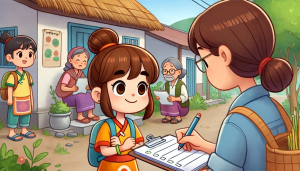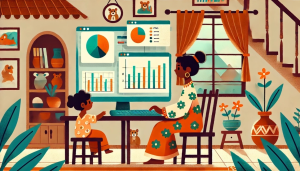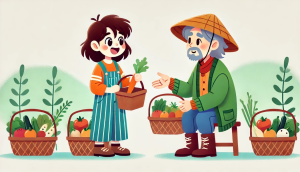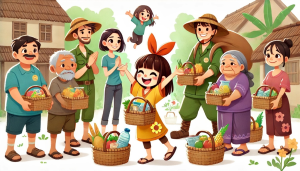The Discovery
Kiki was a bright and curious girl who loved to help others. One day, while on a trip to a nearby village, she noticed that many people didn’t have enough food. This made Kiki sad, and she wanted to find a way to help.
When she returned home, she talked to her mom about it. “Mom, how can we help the people in the village get more food?”
Her mom, a data scientist, smiled and said, “Kiki, we can use data to understand the problem and find a solution. Would you like to learn how?”
Kiki nodded eagerly. “Yes, please!”

What is Data?
Kiki’s mom explained, “Data is information that we collect to learn more about something. It can be numbers, words, pictures, or sounds. We use data to make decisions every day.”
“To start, we need to collect data about the village,” her mom continued. “We’ll ask questions like: How many people live there? How much food do they have? What kind of food do they need?”
Kiki understood that collecting data was like gathering clues to solve a mystery.

Collecting Data
Kiki and her mom went to the village and started talking to the villagers. They asked questions and wrote down the answers in a notebook. Kiki asked about the types of food people had, how often they ate, and what foods they wished they had more of.
Back at home, Kiki organized the information. She created a list with two types of data: qualitative (descriptive) data, like the kinds of food people preferred, and quantitative (numerical) data, like the number of meals each family had per day.

Analyzing the Data
Kiki’s mom showed her how to use graphs and charts to analyze the data. They made a bar graph showing the number of meals each family had per day and a pie chart to display the types of food the villagers needed most.
“Look, Mom,” Kiki said, “most families don’t have enough vegetables and fruits. And many only eat two meals a day.”
“This is great work, Kiki,” her mom said. “Now we know what the village needs most. We can use this data to find a solution.”

Finding Solutions
Kiki thought about how they could help the village. She decided to organize a food drive and reach out to local people for donations of fresh produce.
They used the data to create a plan. Kiki made a schedule for collecting and distributing the food, ensuring that each family received what they needed. She also arranged for volunteers to help with the deliveries.

Spreading Kindness
The food drive was a success. The villagers received the fresh fruits and vegetables they needed, and everyone had enough to eat. Kiki felt proud and happy seeing the smiles on their faces.
But Kiki didn’t stop there. She wanted to make sure the village always had enough food. She organized a community garden where villagers could grow their own produce. Using data, she planned the garden layout to maximize the space and ensure a variety of crops.
Kiki also started a weekly cooking class, teaching the villagers how to prepare nutritious meals with the ingredients they had. She used data to tailor the classes to the needs and preferences of the villagers.

The Power of Data and Compassion
Kiki realized that data wasn’t just numbers and charts; it was a powerful tool to help understand problems and find solutions. By using data with kindness and compassion, she made a real difference in the lives of the villagers.
She shared her story with her friends at school, teaching them how to collect and analyze data to help others. Together, they started projects to solve problems in their own community, from reducing waste to organizing events for the elderly.
Kiki’s adventure showed everyone that with data and a caring heart, they could make the world a better place. And so, Kiki continued to use her data skills to spread kindness and compassion, inspiring others to do the same.
